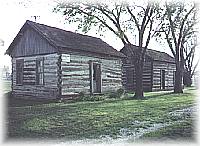Clay County, Kansas
EARLY HISTORY
In April, 1856, Moses, William, and Jerome Younkin, and John P. King,
settled near the mouth of Timber Creek. They were the first white men to
permanently locate within the present limits of Clay County, and it is
pleasing to add that all except Moses have continued to make this
locality their home. During the two succeeding years, a large number
of settlers came into this neighborhood.
The drouth (sic) of 1860 quite completely stopped emigration until
after the war, when after five or six bountiful harvests the settlers
came in plentifully, and the county commenced a new era of progress,
which with the exception of 1875 has been rapid and substantial.
Most of the settlers after the war were soldiers who came to take
advantage of their soldier's claims.
The first marriage occurred the 18th of December, 1859, and the
contracting parties were Lorenzo Gates, the first Postmaster on
Mall Creek, and Miss Lucinda Gill. George H. Purington and
Miss Helen A. M. Morse were married May 6, 1860. In the winter
of 1868-9, John Cain and Miss Alice Arnold were married by
J. B. McLaughlin, Justice of the Peace, who stood on the opposite
bank of the Republican from the contracting parties.
The first birth was that of Edward L., son of Moses and Mrs.
Younkin, occurring December 2, 1858. Joseph Simpson was
born January 5,1859.
September 21, 1860, John A., son of A. Van Nosten died, being
the first death among the settlers.
The first schoolhouse was built of logs in 1864. It was on
Government land, and when nearly completed, Samuel Allen
went to Junction City and filed on the land. A log cabin was
then bought of F. Kuhnle, in which Mrs. Lack taught the first
school in 1865. The first sermon was preached in the county
was delivered in 1863, by Rev. R. P. West of the Methodist
denomination. The Baptists were the first to organize. Dr. J.
W. Shepperd came in 1862, and was the first physician in the
county.
The first mail route on the east side of the river was
established in 1862, between Manhattan and Clifton; on the
west side in 1868, between Junction City and Concordia,
Cloud County. The first daily mails were established when
the first railroad passed through the county--1873.
The first paper in the county was the Clay County Independent,
whose first issue bears the date of August 20, 1871. E. P.
Huston and David Downer were the editors.
In 1861, Orville Huntress brought a stock of goods and opened the
first store. He also opened about the same time the first hotel where
the military road crosses Huntress Creek. In 1865, H. N. Dawson
started the first saw-mill in the county, located on Timber Creek,
and run with horse power.
THE CIVIL WAR
Though an unorganized county with but few inhabitants, none
of whom could have been compelled to enter the service, Clay County
has a war history of which she is justly proud. At the commencement
of the war, there were only forty-three voters in the county, and forty-seven
men enlisted in the Union army, a large number of whom returned to their
new State after the war was over.
The first settlers found the county in possession of the Kaw Indians, who
were comparatively peaceful and harmless people. The war between the
Pawnee and Delaware tribes, in the Smoky Hill valley, in 1857, scared
the settlers, who fled to Riley County, but returned as soon as assured
the war would not extend into their territory.
In 1869-70-71, large numbers of English colonists settled in
the southern part of the county, and by their intelligence and
industry have done much to beautify that portion of the county
and have established for themselves permanent and prosperous
homes in a free country.
Source: Extracted from William G. Cutler's History of the State of Kansas
First published 1883 by A. T. Andreas, Chicago, IL.
CLAY COUNTY TODAY
The beautiful Clay County Courthouse, located at Clay Center, is one
of the county's most treasured landmarks. Civil War and Vietnam war
memorials are located on its grounds.

The Clay County Courthouse
Heritage Row is representative of the early founders of the Clay Center community.
Some of the community's first buildings can be found there. It is located at the
West end of Clay Center on Highway 24.

Heritage Row Cabin
 Return to Home Page
Return to Home Page



Return to Home Page